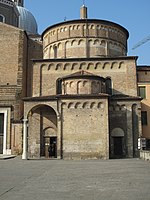Accademia Galileiana

The Accademia Galileiana ('Galilean academy') is a learned society in the city of Padua in Italy. The full name of the society is Accademia galileiana di scienze, lettere ed arti in Padova ('Galilean academy of science, letters and the arts in Padova'). It was founded as the Accademia dei Ricovrati in Padua in 1599, on the initiative of a Venetian nobleman, Federico Cornaro. The original members were professors in the University of Padua such as professor Georgios Kalafatis; one of its original members was Galileo Galilei. In 1779 the academy merged with the Accademia di Arte Agraria (founded in 1769) and became the Accademia di Scienze Lettere e Arti; in 1949 it became the Accademia Patavina di Scienze, Lettere ed Arti; its name was changed to Accademia Galileiana di Scienze, Lettere ed Arti in Padova in 1997, in honor of Galileo. The academy is lodged in the Carraresi Palace in Padua.
Excerpt from the Wikipedia article Accademia Galileiana (License: CC BY-SA 3.0, Authors, Images).Accademia Galileiana
Via Accademia, Padua San Giuseppe
Geographical coordinates (GPS) Address Nearby Places Show on map
Geographical coordinates (GPS)
| Latitude | Longitude |
|---|---|
| N 45.4076 ° | E 11.871 ° |
Address
Via Accademia
35139 Padua, San Giuseppe
Veneto, Italy
Open on Google Maps









